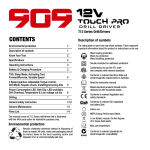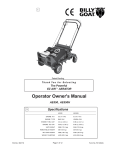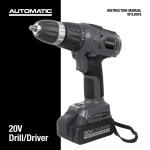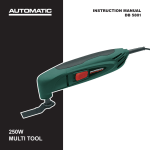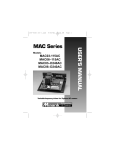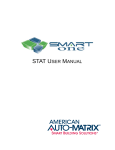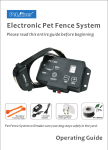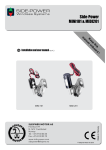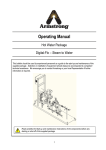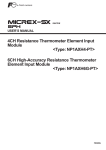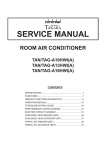Download 909 T12ID4 Use and Care Manual
Transcript
T12ID4 Impact Driver CONTENTS Description of symbols Environmental protection 1 Description of symbols 1 The rating plate on your tool may show symbols. These represent important information about the product or instructions on its use. Know Your Tool 2 Specifications 2 Wear hearing protection Wear eye protection Wear breathing protection Operating Instructions 3 Double insulated for additional protection. Battery & Charging Procedure 3 TSG, Sleep Mode, Activating Tool, Forward/Reverse, Variable Speed Conformance to use the ETL mark and complies with relevent standards 4 LED worklight, Power Consumption LED Belt Clip, Temperature & Low voltage cut out, Hex chuck Installing/removing bits, Tightening Torque, Fastening with Screws Running Nuts and Bolts, General safety instruction General Maintenance Parts List Conforms to relevant Electrical Stds and electromagnetic requirements in Australia. 5 Read the instruction manual 6 Waste electrical products should not be disposed of with household waste. Conforms to relevant legislation and safety standards. Conforms to relevant GS Legislation and safety Stds Indoor use MEPS Energy Performance Mark. Li ion Battery recycle. Do Not dispose of in house hold waste. Max.use temperature 7-12 12 5424 14 This manual covers all T12 Series Impact Drivers but is illustrated with the 4A/h pack option for illustration purposes only. Environmental protection Recycle unwanted materials instead of disposing of them as waste. All tools, hoses and packaging should be sorted, taken to the local recycling centre and disposed of in an environmentally safe way. Conforms to relevant standards for electromagnetic compatibility. Know Your Tool 1. Chuck 2. LED worklight 1. 3. Forward Touch Pad 4. Reverse Touch Pad 5. Power Consumption LED 6. Battery release button 7. Rechargeable Lithium-ion battery pack 8. Charger 5. 2. 9. Charging status indicator 3. 10. Detachable cable & plug 11. Accessory mount Specifications Motor: 4. 12 V Impact Driver / Wrench speed: 0 - 2300 min-1 Impact Rate: 3000 BPM Max. torque: 100Nm, 885 in-lbs Chuck Collet Hex: 6.35mm (1/4) Battery: 11. 6. 7. TB12 Series Lithium-Ion Model # TB122A TB1225A TB123A TB124A TB125A 12V 12V 12V 12V 12V 2Ah 2.5Ah 3Ah 4Ah 5Ah Charger type: Model 7110 Input: 100 – 240Vac 50/60Hz 65W Output: 12 V Charging time: Approx 60 min - 4Ah Battery Approx 30 min - 2Ah Battery For further detailed up to date specifications and for Warranty details, visit our website at 909.com 9. 8. 10. 2 OPERATING INSTRUCTIONS WARNING! CHARGER DIAGNOSTICS The charger is designed to detect certain problems that can arise with battery packs. • Do not allow familiarity with tools to make you careless. Remember that a careless fraction of a second is enough to cause serve injury. • Before attempting to use this cordless Impact driver, become familiar with all of its operating features and safety requirements. • To reduce the risk of serious personal injury, turn tool off and disconnect battery pack before making any adjustments or removing/installing attachments or accessories. • When the charger detects a battery pack that is overheated, all three charging light will blink at the same time. Please remove the battery and allow it to cool down for 15 – 30 minutes and re-insert. • When the charger detects malfunction in the battery or the charger, two charging lights will blink at the same time. Please remove the battery and allow to cool down for 15-30 minutes. Then reinsert the battery pack into the charger, if two charging lights still flashes, the battery or charger may require service. NOTE: Charging times maybe longer depending on the surrounding temperature and battery conditions. CHARGING PROCEDURE • Connect the plug cable to the charger, and then plug into an appropriate outlet before inserting battery pack. After approx 5 sec, all three charging lights will be on for two seconds and then off, indicating power is available at the charger. (fig. A) • Insert the battery pack into the charger, making sure the pack is fully seated in the charger. The charging process has now begun. (fig. B) Fitting and removing the battery pack to the driver • To install the battery pack to the tool, align the raised portion of the battery pack with the grooves on the bottom of the drill, and slide it firmly into the handle until you hear the lock snap into place. (fig. C) • To remove the battery pack from the tool, press the battery pack release button and slide the battery pack completely out of tool handle. A During the charging process, the charging lights will indicate the charging status as below: - Less than 30% charged, all three charging lights will blink in sequence. - Less than 60% charged, one light will stay on, while the other two lights will blink in sequence. B - Over 60% charged, two lights will stay on, while the remaining light will blink continuously. - Fully charged, all three lights will remain on continuously. • As a guide, the charging process will be last approximate 30 min for a 2Ah Battery Pack and approx 60 min for a 4Ah battery pack, and will be displayed by permanent lighting of all three charging lights. C Battery charging CAUTION! • Before attempting to charge the battery, check the charger and the battery to ensure the charging equipment matches the battery supplied. The components are all labeled with component numbers. • T he rechargeable battery is not fully charged on leaving the factory. Charge the rechargeable battery before first use. • Recharge discharged batteries as soon as possible after use or battery life may be greatly diminished. For longest battery life, do not discharge batteries fully. • The working temperature of the charger is 0 degree to 45 degrees (32 degree f to 115 degree f). 3 Touch Sensor Grip Power Tool FORWARD AND REVERSE CAUTION! To prevent damage to the gears, always Congratulations on purchasing a Touch Sensor Grip (TSG) Power tool. The TSG system incorporates a fully electronic control system which operates the tool on pressure applied to the Touch area, instantaneously allowing operation between Forward and reverse. allow the chuck to come to a complete stop before changing the direction of rotation. • The unique TSG System allows quick and single handed change between forward and reverse. For forward mode, simply apply pressure the Forward Touch Pad area. To switch to reverse mode, simply release you finger from Forward Touch Pad and pressure the Reverse Touch Pad area instead. (fig. F) • Applying screws, nuts and other fasteners in general uses the forward mode. The reverse mode is intended for the removal of screws, nuts and other fasteners. Tools fitted with TSG are truly a left and right handed tool, easy to operate and is the latest technology in Power Tool development Touch Sensor Grip (TSG) CAUTION! Your 12V 909 impact driver is equipped with the innovative TSG System. It is important to read and understand the following instructions to get the best use of the TSG system. F VARIABLE SPEED CAUTION: The variable speed control function is NOT (fig. D) ACTIVATE THE TOOL D intended to be used for long periods of time during the operation of the task being performed. Use the variable speed to start screwing tasks, and then fully press the switch once the task has started. • The TSG system enables the user to adjust the speed of the driver effortlessly. The speed varies according to the amount of pressure is applied on the Touch pad area in either forward or reverse. The higher the pressure applied, the higher speed of the driver. • To stop the driver, release the finger from the Forward or Reverse Touch Pad area and allow the chuck to come to a complete stop. The electric brake quickly stops the chuck from rotating. This feature engages automatically when fingers are released from TSG system in either forward or reverse • Fit the tool with a fully charged battery pack by following the section Fitting and removing the battery pack to the driver on page 3. • Hold the tool naturally, with your index finger on the Forward Touch Pad and the middle finger on the Reverse Touch pad. • Firmly press the Forward and Reverse Touch Pad at the same time to activate the tool. Both LED work light and Power Consumption LED will light up to indicate a successful activation. (fig. E) • Release the fingers from Forward and Reverse Pad. The tool is awakened from the sleep mode and ready for use. SLEEP MODE NOTE: For speed control, there is no need to squeeze hard on the E Touch Pad. The innovative technology can detect small changes of pressure applied and adjust the speed accordingly. • To avoid accidental start, the tool will automatically enter sleep mode if the user does not operate the tool within any 5 min interval • In the case where the tool has not been used for the 5 min period, the tool needs to be re activated to allow the remaining functions of the driver to be used. To activate the tool, please follow the section above, Activate the tool. NOTE: This driver is equipped with an electric brake. When the brake is functioning properly, sparks may be visible through the vent slots in the housing. This is normal and is the action of the brake. First time users to familiarise themselves with the sensitivity of the TSG should squeeze the Touch area and experience the functions before fitting a drill or driver bit. 4 LED worklight NOTE: • The driver will not restart until the battery pack has cooled. To reduce the temperature of the cells remove the When the unit is switched on, the LED worklight also comes on to ensure better vision and to make working in dark areas safer. The worklight goes out when the TSG system is released. battery pack from the driver and place the battery pack in a free air environment, out of direct sunlight or any other heat source. • DO NOT force cool the pack in any way. Do not place in refrigerators or freezers. When the battery pack has cooled down it can again be used to operate the driver, as long as the load or the conditions causing the original excessive temperature has been corrected. Power Consumption LED This LED indicates the amount of battery power available for your task. At activation the LED will glow as detailed below. During operation the LED will alter according to the amount of load being applied. • Green light: the battery remaining power is above 60% • Yellow light: the battery remaining power is between 30% to 60%. • Red light: The battery remaining power is less than 30%. Re-charge the battery as soon as possible. Low voltage cut out This tool is fitted with a low voltage cut out feature to assist in providing a long life to the battery. When the battery is close to the pre-set minimum low voltage level, the power consumption LED will be red and the tool will turn off. Belt clip You will then need to insert either a fully charged battery pack into the driver or recharge the existing battery pack. The belt clip is used to assist to clip the tool to your waist belt while working. Install the clip to the driver by locating the belt clip tabs in the slots in the driver and tighten the screw to fix the clip firmly. (fig. H) CAUTION! Note: Attempting to restart the tool without either recharging the battery or installing another battery (with charge) will lead the driver restarting and then stopping again, after only a few seconds of operation. Impact driver hex chuck H • When using the belt clip, ensure the tool is secure and cannot drop from the waist belt. If the power tool is dropped, it may lead to an accident. • When carrying the tool when hooked to your waist belt, do not fit any type of accessory to the chuck of the power tool, it may lead to accidental injury. The Touch Impact driver is supplied with an impact driver collect chuck. The chuck is designed to use standard 6.35mm (1/4 inch ) screwdriver and nut driver bits. When purchasing screwdriver and nut drivers the highest quality accessories are recommended. Temperature cut out Bits with a machined undercut provide the best fitment into the collet. If the driver is constantly overloaded, or the driver is used constantly at maximum rating in high ambient conditions, the battery cells may over heat causing the battery pack to shut down. When this Note: If bits are used without the undercut machined in the driver bit, there is NO re tension of the bit, and the bit can fall free from the chuck without releasing the chuck sleeve. It is always better to use bits with the machined undercut. occurs you will need to immediately stop driving and allow the battery cells to cool. 5 Inserting a driver or nut setter bit into the impact driver attachment Soft case: The joining of e.g metal to wood or insulation material. For middle or soft joining cases, the maximum tightening torque is less than for hard cases. Therefore, a longer impacting/tightening action is necessary to arrive at the maximum tightening torque. WARNING! Do not insert or remove bits while the tool is activated. Make sure the battery pack is removed or the tool is in sleep mode when inserting or removing bits. Fastening with Screws 1. Your tool is equipped with a quick release chuck. To insert an accessory, simply pull the locking sleeve forward, insert the desired accessory fully into the chuck and release the locking sleeve. (Fig G) 2. To remove an accessory, pull the locking sleeve forward and simply remove the accessory from the chuck. This procedure will enable you to fasten materials together with your tool without stripping, splitting or separating the material (fig I) Note: Always use a test piece to determine the correct time to allow the impact driver to impact. The longer the impact time when seating the screw, the higher the torque being applied. Small screws can easily strip or shear if over tightened. The following is a guide but application will vary between screws and materials being screwed together. G 3. To avoid loss of control, ensure the bit is locked into the chuck by pulling on the bit after it has been inserted and the locking sleeve released. The most IMPORTANT point is to learn the impact time when seating the screw. First, clamp the pieces together and drill the first hole 2/3 the The technique is to start slowly, increasing the speed as the screw runs down. Set the screws snugly by slowing to a stop. Prior to driving screws, the right impacting/tightening duration can be reached in less than 0.5 seconds. Therefore, work with low RPM and switch the machine off immediately when the screw is tight and the impacting sound is heard. diameter of the screw. If the material is soft, drill only 2/3 the proper length. If it is hard, drill the entire length. Second, unclamp the pieces and drill the second hole the same diameter as the screw shank in the first or top piece of wood. Third, if flat head screw is used, countersink the hole to make the screw flush with the surface. Then, simply apply even pressure when driving the screw. The screw shank clearance hole in the first piece allows the screw head to pull the pieces tightly together. For screwing larger, longer wood screws into hard material, pre-drilling is the best method. Tightening Torque The tightening torque depends on the duration of the impacting/ tightening action. The largest tightening torque is achieved after approx. 6 to 10 seconds impacting/tightening action. The torque build up depends on the following factors: • Hardness of the bolts/nuts. • Type of washer (disk washer, spring washer, seal). • Hardness of the material to be joined. • Lubricating effect at the surfaces of the junction. This leads to the following application cases: Hard case: The joining of metal to metal with a disk washer. The maximum torque is reached after a relatively short impacting/ tightening action. Medium case: The joining of metal to metal where the spring ring washer, disk spring washer, stud bolts or bolts/nuts with conical seats are used. 6 I Running Nuts and Bolts 2). ELECTRICAL SAFETY •Power tool plugs must match the outlet. Never modify the plug in any way. Do not use any adapter plugs with grounded power tools. Unmodified plugs and matching outlets will reduce risk of electric shock. Variable speed control must be used with caution for driving nuts and bolts with socket set attachments. The technique is to start slowly, increasing speed as the nut or bolts run down. Set the nut or bolt snugly by allowing the impact driver to impact the nut to the desired torque. This is a achieved by the time the impact driver is allowed to impact the nut. A very short impact of say 0.5 seconds will be a low torque. An impact of 5 seconds will result in a very high torque. It is ALWAYS advisable to test the torque and determine what time frame is required to achieve the desired result. •Avoid body contact with grounded surfaces such as pipes, radiators, ranges and refrigerators. There is increased risk of electric shock if your body is grounded. •Do not expose power tools to rain or wet conditions. Water entering a power tool will increase the risk of electric shock. WARNING. This impact driver is capable of tightening fasteners to a very high torque. Over tightening can result in shearing bolts and screws, especially if low quality fasteners are used. Do Not over tighten fasteners and impact only to achieve the desired torque. •Do not abuse the cord. Never use the cord for carrying, pulling or unplugging the power tool. Keep cord away from heat, oil, sharp edges or moving parts. Replace damaged cords immediately. Damaged or entangled cords increase the risk of electric shock. General safety instructions for handling power tools (European locations) WARNING! Read all safety warnings and all •When operating a power tool outdoors,use an extension cord suitable for outdoor use.Use of a cord suitable for outdoor reduces the risk of electric shock. instructions. Failure to follow the warnings and instructions may result in electric shock, fire and/or serious injury. •To reduce the risk of electric shock, the manufacturer recommends the use of a residual current of 30mA or less at all times. This unit may not be used by people (including children) with reduced physical, sensory or mental capacities, with a lack of experience and without the appropriate knowledge, unless they are supervised by someone who is responsible for their safety or have been instructed by such a person with regard to how the unit is to be operated. 3). PERSONAL SAFETY •To reduce the risk of electric shock, the manufacturer recommends the use of a residual current of 30mA or less at all times. •Stay alert, watch what you are doing and use common sense when operating a power tool. Do not use a power tool while you are tired or under the influence of drugs, alcohol or medication. A moment of inattention while operating power tools may result in serious personal injury. Children should be supervised to ensure that they do not play with the device. Save all warnings and instructions for future reference •Use personal protective equipment. Always wear eye protection. Protective equipment such as dust mask, non-skid safety shoes, hard hat, or hearing protection will reduce personal injures. 1). WORK AREA SAFETY •Keep work area clean and well lit. Cluttered or dark areas invite accidents. Rags, cloths, cord, string and similar items should never be left around the work area •Prevent unintentional starting. Ensure the switch is in the “off” position before connecting to power source and/or battery pack, picking up or carrying the tool. Carrying power tools with your finger on the switch or energising power tools that have the switch on invites accidents. • Do not operate power tools in explosive environments, such as in the presence of flammable liquids, gases, or dust. Power tools create sparks, which may ignite the dust or fumes. •Remove any adjusting key or wrench before turning the power tool on. A wrench or key left attached to a rotating part of the power tool may result in personal injury. •Keep children and bystanders away while operating a power tool. Distractions can cause the operator to lose control. 7 risk of fire when used with another battery pack. •Do not overreach. Keep proper footing and balance at all times. This enables better control of the power tool in unexpected situations. •Use power tools only with specifically designated battery packs.Use of any other battery packs may create a risk of injury and fire. •Dress properly. Do not wear loose clothing or jewellery. Keep your hair, clothing and gloves away from moving parts. Loose clothes, jewellery or long hair can be caught in moving parts. •When the battery pack is not in use, keep it away from other metal objects ,like paper clips, coins,keys, nails, screws or other small metal objects that can create a connection between the terminals. Shorting the battery teminals together may cause bums or a fire. •If devices are provided for the connection of dust extraction and collection facilities , ensure these are connected and properly used. Use of dust collection can reduce dust-related hazards. •Avoid contact with any liquid that is emitted by a batttery. If the battery pack is abused, liquid may escape from the battery. Liquid emitted from the battery may cause irritation or burns. If liquid comes into contact with the skin, wash the area immediately with soap and water, and then neutralize the liquid with lemon juice or vinegar. If contact occurs, rinse thoroughly with running ater. If liquid comes into contact with the eyes, rinse thoroughly with running water and seek medical help. 4). POWER TOOL USE AND CARE •Do not force the power tools. Use the correct power tool for your application. The correct power tool will do the job better and safer at the rate for which it was designed. •Do not use the power tool if the switch does not turn it “on” and “off”. Any power tool that cannot be controlled with the switch is dangerous and must be repaired. •Store battery pack in well ventilated, dry and cool conditions, and avoid direct sunlight and rain. •Disconnect the plug from the power source and/or the battery pack from the power tool before making any adjustments, changing accessories, or storing power tools. Such preventive safety measures reduce the risk of starting the power tool accidentally. 6). SERVICING •Have your power tool serviced by a qualified repair person using only identical replacement parts. This will ensure that the safety of the power tools is maintained. •Store idle power tools out of the reach of children and do not allow persons unfamiliar with the power tool or these instructions to operate the power tool. Power tools are dangerous in the hands of untrained users. SAFETY WARNINGS FOR CORDLESS DRILLS • Wear ear protectors when impact drilling. Exposure to noise can cause hearing loss. •Maintain power tools with care. Check for misalignment or binding of moving parts, breakage of parts and any other condition that may affect the power tool’s operation. If damaged, have the power tool repaired before use. Many accidents are caused by poorly maintained power tools. •Hold power tools by insulated gripping surface ,when performing an operation where the cutting accessory or fastener may contact hidden wiring. Cutting accessory and fasteners contacting a “live” wire may make exposed metal parts of the power tool “live” and could give the operator an electric shock. •Keep cutting tools sharp and clean. Properly maintained cutting tools with sharp cutting edges are less likely to bind and are easier to control. •Use appropriate detectors to determine if utility lines are hidden in the work area or call the local utility company for assistance. Contact with electric lines can lead to fire and electric shock. Damaging a gas line can lead to ecplosion.Penetraing a water line causes property damage or may cause an electric shock. •Use the power tool, accessories and tool bits etc. in accordance with these instructions, taking into account the working conditions and the work to be performed. Use of the power tool for operations different from those intended could result in a hazardous situation. •Switch off the power tool immediately when the tool inserts jams. Be prepared for high reaction torque that can cause kickback. The tool inserts jams when: 5). USE AND CARE OF THE BATTERY PACK •Verify that the switch is in the “off” position before inserting the battery pack. Inserting the battery pack into a power tool that has the switch in the “on” position invites accidents - the power tool is subject to overload or - it becomes wedged in the workpiece. •Recharging only with the charger specified by the manufacturer. A charger that is suitable for one type of battery pack may create a 8 •Hold the machine with a firm grip. High reaction torque can briefly occur while driving in and loosening screws. •Secure the workpiece. A workpiece clamped with clamping devices or in a vice is held more secure than by hand. up yourself, have it repaired by a qualified specialist only and with original replacement parts. A damaged charger, cable or plug will increase the risk of an electrical shock. •Keep your workplace clean. Blends of materials are particularly dangerous.Dist from light alloys can burn or explode. •Never operate the charger on a surface that will burn easily (for example, paper, textiles etc) or in a flammable environment. There is a risk of fire occurring as a result of the heat generated during the charging process. •Do not open the battery. Danger of short-circuiting. •In case of damage and improper use of the battery, vapours may be emitted Provide for fresh air and seek medical help in case of complaints. The vapours can irritate the respiratory system. •Fluid can escape from the battery when used incorrectly. Avoid all contact with this. In the event of accidental contact, rinse with water. If liquid should get into the eyes, get medical assistance. Battery fluid may result in skin irritations and burns. •Use the battery only in conjunction with this power tool. This measure alone protects the battery against dangerous overload. •Use only original 909 batteries with the voltage listed on the nameplate of your power tool. When using other batteries, e.g, imitations, reconditioned batteries or other brands, there is danger of injury as well as property damage through exploding batteries. •Do not open the battery. There is a risk of short-circuiting. •Protect the battery from heat, for example, from constant sun and fire. There is a risk of explosion. •Never short circuit the battery. There is a risk of explosion. ADDITIONAL INSTRUCTIONS FOR WORK WITH THE BATTERY/CHARGER WARNING: If the battery pack is cracked or damaged •In the event of damages and incorrect use, vapours may come out of the battery. Ensure plenty of fresh air and, if you have any symptoms, consult a doctor. These vapours may irritate the respiratory system. General safety instructions for handling power tools (North America) WARNING! in any other way, do not insert it in the charger. There is a danger of electric shock. WARNING: Do not allow any liquid to come into contact with the charger. There is a danger of electric shock. • Before operating this tool, carefully read this Instruction Manual and all of the labels affixed to the tool. Failure to follow all warnings and instructions may result in electric shock, fire and/or serious injury. • The term “power tool” in the warnings refers to your mains operated (corded) power tool or battery operated (cordless) power tool. • Save all warnings and instructions for future reference. •Before using the charger, read all the instructions and cautionary markings on the charger and battery pack as well as the instructions on using the battery pack. •Keep the charger away from rain or damp. Water entering into the charger will increase the risk of an electrical shock, •Only use chargers recommended by the manufacturer to recharge the battery. When using a charger designated for a particular type of battery, there is a risk of fire if it is used with other batteries. WARNING! Some dust created by power sanding, sawing, grinding, drilling and other construction activities contains chemicals known to the state of California to cause cancer, birth defects or other reproductive harm. Some examples of these chemicals are: • Lead from lead-based paints. • Crystalline silica from bricks, cement, and other masonry products. • Arsenic and chromium from chemically treated lumber. •Never use to recharge third-party batteries. The charger is only designed to charge the supplied batteries (Li-Ion) using the voltages specified in the Technical Data. Otherwise there is a risk of fire or explosion. •Keep the charger clean. Contamination will increase the risk of an electrical shock. •Check the charger, cable and plug each time you use the unit. Do not use the charger if you find any damages. Never open the charger 9 Your risk from these exposures varies, depending upon how often you do this type of work. To reduce your exposure to these chemicals: • Work in a well-ventilated area. • Work with approved safety equipment, such as dust masks that are specially designed to filter out microscopic particles. • Avoid prolonged contact with dust from power sanding, sawing, grinding, drilling, and other construction activities. Wear protective clothing and wash exposed areas with soap and water. Allowing dust to get into your mouth or eyes or to lie on the skin may promote absorption of harmful chemicals. • When operating a power tool outdoors, use an extension cord suitable for outdoor use. Use of a cord suitable for outdoor use reduces the risk of electric shock. • If operating a power tool in a damp location is unavoidable, use a residual current device (RCD) or ground fault circuit interrupter (GFCI) protected supply. Use of an RCD or GFCI reduces the risk of electric shock. Personal safety • Stay alert, watch what you are doing and use common sense when operating a power tool. DO NOT use a power tool while you are tired or under the influence of drugs, alcohol or medication. A moment of inattention while operating power tools may result in serious personal injury. Work area safety • Keep work area clean and well lit. Cluttered or dark areas invite accidents. Rags, clothes, cords, strings and similar items should never be left around the work area. • Use personal protective equipment. Always wear eye protection. Protective equipment such as a dust mask, non-skid safety shoes, a hard hat, or hearing protection will reduce personal injuries. • Do not operate power tools in explosive environments, such as in the presence of flammable liquids, gases, or dust. Power tools create sparks, which may ignite the dust or fumes. • Avoid accidental starting. Ensure the switch is in the “off” position before connecting to a power source and/or battery pack, or picking up or carrying the tool. Carrying power tools with your finger on the switch or plugging in power tools that have the switch “on” invites accidents. • Keep children and bystanders away while operating a power tool. Distractions can cause the operator to lose control. Electrical safety • Remove any adjusting key or wrench before turning the power tool on. A wrench or key left attached to a rotating part of the power tool may result in personal injury. • Power tool plugs must match the outlet. Never modify the plug in any way. Do not use any adaptor plugs with grounded power tools. Unmodified plugs and matching outlets will reduce risk of electric shock. • Do not overreach. Keep proper footing and balance at all times. This enables better control of the power tool in unexpected situations. • Avoid body contact with grounded surfaces such as pipes, radiators, ranges and refrigerators. There is an increased risk of electric shock if your body is grounded. • Do not expose power tools to rain or wet conditions. • Dress properly. Do not wear loose clothing or jewellery. Always wear eye and ear protection and use a dust mask. Keep your hair, clothing and gloves away from moving parts. Loose clothes, jewelry or long hair can be caught in moving parts. Water entering a power tool will increase the risk of electric shock. • If devices are used for dust extraction and collection, ensure these devices are connected and used properly. Use of dust collection devices can reduce dust-related hazards. • Do not abuse the cord. Never use the cord for carrying, pulling or unplugging the power tool. Keep the cord away from heat, oil, sharp edges or moving parts. Replace damaged cords immediately. Damaged or tangled cords increase the risk of electric shock. • Do not use on a ladder or unstable support. Stable footing on a solid surface allows for better control of the power tool in unexpected situations. 10 Power tool use and care Battery tool use and care • Do not force the power tool. Use the correct power tool for your application. The correct power tool will do a better and safer job if used for the function it was designed for. • Ensure the switch is in the "off" position before inserting the battery pack. Inserting the battery pack into power tools that have the switch "on" invites accidents. • Do not use the power tool if the switch does not turn it on and off. Any power tool that cannot be controlled with the switch is dangerous and must be repaired. • When recharging, use only the charger that is specified by the manufacturer. A charger that is suitable for one type of battery pack may create a risk of fire when used with another battery pack. • Disconnect the plug from the power source and/or the battery pack from the power tool before making any adjustments, changing accessories, or storing the power tool. Such preventive safety measures reduce the risk of • Use only specifically designated battery packs with power tools. The use of any other battery pack may create a risk of injury or fire. starting the power tool accidentally. • When the battery pack is not in use, keep it away • Store idle power tools out of the reach of children and do not allow persons unfamiliar with the power tool or these instructions to operate the power tool. Power from objects that can create a connection between the terminals, such as paper clips, coins, keys, nails, screws or other small metal objects. Short-circuiting the tools are dangerous in the hands of untrained users. battery terminals may cause burns or a fire. • Maintain power tools with care. Check for misalignment or binding of moving parts, breakage of parts and any other condition that may affect the power tool’s operation. If damaged, have the power tool repaired before use. Many accidents are caused by poorly maintained power tools. • Under abusive conditions, liquid may be ejected from the battery; avoid contact. If contact accidentally occurs, flush with water. If liquid contacts eyes, seek medical help. Liquid ejected from the battery may cause irritation or burns. Service • Keep cutting tools sharp and clean. Properly maintained cutting tools with sharp cutting edges are less likely to bind and are easier to control. • Have your power tool serviced by a qualified repair person using only identical replacement parts. This will ensure that the safety of the power tool is maintained. • Use the power tool, accessories, tool bits, etc., in accordance with these instructions, taking into account the working conditions and the work to be performed. Use of the power tool for operations different from • When servicing a tool, use only identical replacement parts. Follow the instructions in the Maintenance section of this manual. The use of unauthorized parts or failure to follow maintenance instructions may create a risk of electric shock or injury. those intended could result in a hazardous situation. 11 Specific safety rules for cordless drill/driver • The length of service from your battery will depend on the type of work you are doing. The battery has been designed to provide maximum trouble-free life. However, like all batteries, it will eventually wear out. • Hold power tool by insulated gripping surface when performing an operation where the cutting tool may contact hidden wiring or its own cord. Contact with a “live” wire will also make exposed metal parts on the tool “live” and shock the operator. • To obtain the longest possible battery life, we suggest the following: • Wear hearing protection during extended periods of operation. Exposure to noise can cause hearing loss. - Store and charge your battery in a cool area. Temperatures above or below normal room temperature will shorten battery life. • Use auxiliary handle(s), if supplied with the tool. Loss of control can cause personal injury. • Wear safety goggles or other eye protection. Hammering and drilling operations cause chips to fly. Flying particles can cause permanent eye damage. - Never store the battery in a discharged condition. Recharge it immediately after it has been discharged. • All batteries gradually lose their charge. The higher the temperature, the quicker they lose their charge. If you store your tool for long periods of time without use, recharge the battery every month or two. This practice will prolong battery life. • Use a dust mask or respirator for applications if the operation is dusty. Battery pack removal and preparation for recycling • Secure the workpiece. Clamping devices or a vise will hold the workpiece in place better and more safely than holding it by hand. To preserve natural resources, please recycle or dispose of batteries properly. This product contains a lithium-ion battery. Local, provincial or federal laws may prohibit disposal of lithium-ion batteries in ordinary trash. Consult your local waste authority for information regarding available recycling and/or disposal options. WARNING! Upon removal, cover the battery pack’s terminals with heavy-duty adhesive tape. Do not attempt to destroy or disassemble. • Be aware that this tool is always in an operating condition, since it does not have to be plugged into an electrical outlet. • Accessories and tool may get hot during operation. Wear gloves when handling them if performing heat producing applications such as drilling metals. Safety rules for battery pack and charger WARNING! This manual contains important safety and General maintenance Avoid using solvents when cleaning plastic parts. Most plastics are susceptible to damage from various types of commercial solvents and may be damaged by their use. Use clean cloths to remove dirt, dust, oil, grease, etc. operating instructions for your battery and charger. Before using the charger, read all instructions and warnings on the charger, the battery pack and the tool. WARNING! • If the battery pack casing is cracked or damaged, do not insert into charger. There is a danger of electric shock or electrocution. • To avoid serious personal injury, always remove the battery pack from the tool when cleaning or performing any maintenance. • When servicing, use only identical replacement parts. Use of any other parts may create a hazard or cause prod uct damage. To ensure safely and reliability, all repairs should be performed by a qualified service technician. • It is not recommended to use compressed dry air to clean the driver. If cleaning with compressed air is the only method available, always wear safety goggles or safety glasses with side shields when using compressed , • Don t allow any liquid to get inside charger. Electric shock may result. To facilitate cooling of the battery pack after use, avoid placing the charger or battery pack in a warm environment such • Never attempt to open the battery pack for any reason. If the plastic housing of the battery pack breaks or cracks, immediately • Never attempt to open the battery pack for any reason. If the plastic housing of the battery pack breaks or cracks, immediately discontinue use and do not recharge. 12 Battery pack removal and preparation for recycling air to clean the tool. If the operation is dusty, also wear a dust mask. • Do not at any time allow brake fluids,gasoline, petroleum - based products, penetrating oils,etc, to come in contact with plastic parts. Chemicals can damage, weaken or destroy plastic which may result in serious personal injury. To preserve natural resources, please recycle or dispose of batteries properly. This product contains lithium-ion batteries. Local, state, or federal laws may prohibit disposal of lithium-ion batteries in ordinary trash. Consult your local waste authority for information regarding available recycling and/or disposal options. WARNING! Upon removal of the battery pack for disposal or recycling, cover the battery pack’s terminals with heavy-duty adhesive tape. Do not attempt to destroy or disassemble the battery pack or remove any of its components. Lithium-ion batteries must be recycled or disposed of properly. Also, never touch the terminals with metal objects and/or body parts as a short circuit may result . Keep away from children. Failure to comply with these warnings could result in fire and/or serious injury. Batteries The battery pack is equipped with Lithium-ion rechargeable batteries. The duration of use from each charge will depend on the type of work performed. The batteries in this tool have been designed to provide maximum trouble-free life. Like all batteries, they will eventually wear out. Do not disassemble the battery pack or attempt to replace the batteries. Handling of the batteries, especially when wearing rings and Jewelry, could result In a serious burn. To ensure safety and reliability, all repairs should be performed by a qualified service Agent To obtain the longest possible battery life, read and understand the operator’s manual. Waste disposal • It Is good practice to unplug the Charger/Adapter and remove the Lithium-ion battery pack when not In use. The product must not be discarded with normal household waste. It must be disposed of properly. For Lithium-ion battery pack storage longer than 30 days: • Store the Lithium-ion battery pack where the temperature Is below 80 “F (26°C) and free of moisture. • Store Lithium-ion battery packs in a 30%-50% charged condition. • Every six months of storage, fully charge the Lithium-ion battery pack. • Exterior may be cleaned with a cloth or soft non-metallic brush. 13 Parts list If any parts are missing or damaged, or if you have any questions, please email us at [email protected] 14 OTHER MODELS AVAILABLE: 12V Drill/Driver 15 909Powertools W: 909.com E: [email protected] © Globalpowerbrands International P/L 2013
















